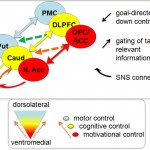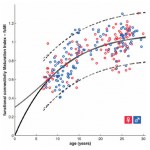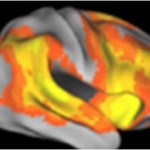cognitive neuroscience
In their wonderful Neuroimage article, Braun & Mattia present a comprehensive introduction to the possible neuronal implementations and cognitive sequelae of a particular dynamical phenomenon: the attractor state. In another excellent paper, just recently out in Frontiers, Itskov, Hansel and Tsodyks describe how such attractor dynamics may be insufficient to support working memory processing unless supplemented by rapid synaptic modification - a mechanism which has in fact been described neuroanatomically and previously utilized neurocomputationally to describe cognitive phenomena. To…
If you ever said to yourself, "I wonder whether the human mid- and posterior ventrolateral prefrontal cortex has a homologue in the monkey, and what features of its cytoarchitecture or subcortical connectivity may differentiate it from other regions of PFC" then this post is for you.
Otherwise, move along.
The mid/posterior ventrolateral prefrontal cortex (pars opercularis and pars triangularis, or Brodmann's Areas 44 and 45) is very clearly different, both anatomically and functionally, from its anterior sector (which involves the pars orbitalis, or Brodmann's Area 47). It is also probably…
Suppose - rather reasonably - that soups which taste like garlic have garlic in them. You observe two people eating soup; one of them says to the other, "There is no garlic in this soup." Do you think it's likely that the soup taste like garlic?
If you said yes, then congratulations! You've just committed a logical fallacy (from the premise "if p then q" and "not q," you have inferred p) so absurd that it's only very recently been given a name. But don't feel bad - this absurd inference, known as modus shmollens, can actually be elicited from a majority of adult human subjects when the…
Last month's Frontiers in Psychology contains a fascinating study by Dambacher, HuÌbner, and Schlösser in which the authors demonstrate that the promise of financial reward can actually reduce performance when rewards are given for high accuracy. Counterintuitively, performance (characterized as accuracy per unit time) is actually better increased by financial rewards for response speed in particular.
The authors demonstrated this surprising result using a flanker task. In Dambacher et al's "parity" version of the flanker, subjects had to determine whether the middle character in strings…
Owing to the low signal-to-noise ratio of functional magnetic resonance imaging, it is difficult to get a good estimate of neural activity elicited by task novelty: by the time one has collected enough trials for a good estimate, the task is no longer novel! However, a recent J Neurosci paper from Cole, Bagic, Kass & Schneider circumvents this problem through a clever design. And the design pays off: the results indicate that the widely-hypothesized anterior-to-posterior flow of information through prefrontal cortex may actually be reversed when unpracticed novel tasks need to be…
How do we detect important items in our environment? This crucial capacity has received less attention than one might think, and a number of extremely basic issues remain to be explored. For example, it has long been known that target probability has profound effects on the recruitment of the prefrontal cortex (such that lower-probability targets are associated with greater recruitment of both dorsolateral and ventrolateral prefrontal cortex), it has been unclear whether this pattern arises due to the general probability of the class of "targets" or whether it's more stimulus-specific.
An…
Sometimes, ground-breaking studies don't get the attention they deserve - even from experts in the field. One great example of this is an elegant study by Nieuwenhuis et al. from CABN in 2003; in it, they conclusively demonstrate why a particular event-related potential - the negative-going frontocentral deflection at around 200ms following stimulus onset, aka the "N2" - reflects the detection of response conflict, and not the demand to inhibit a response.
This would seem to be a tough distinction to demonstrate - after all, the demand to inhibit something would be expected to strongly…
In last week's Science, Dosenbach et al describe a set of sophisticated machine learning techniques they've used to predict age from the way that hemodynamics correlate both within and across various functional networks in the brain. As described over at the BungeLab Blog, and at Neuroskeptic, the classification is amazingly accurate, generalizes easily to two independent data sets with different acquisition parameters, and has some real potential for future use in the diagnosis of developmental disorders - made all the easier since the underlying resting-state functional connectivity data…
With our introduction to paired pulse transcranial magnetic stimulation (ppTMS) out of the way, we now turn to a 2010 PNAS paper by Neubert, Mars, Buch, Olivier & Rushworth in which conditioning TMS is applied to the right inferior frontal gyrus (rIFG) as well as the pre-supplementary motor area (pre-SMA) between 3 and 18ms prior to TMS over the contralateral primary motor cortex (M1). Note that all of these areas are known to interact in exceedingly complex ways based on the task subjects are performing, the intensity of the magnetic stimulation, the relative intensities of the paired…
Yesterday's introduction to paired-pulse transcranial magnetic stimulation elicited an insightful comment from reader "Kix":
As you mention, TMS can be used in order to disrupt or to read out some areas of the brain. I don't see why these functions should be mutually exclusive. For instance, delivering single pulse TMS over the primary motor cortex during movement preparation allows one to guess the direction of the future movement from the size of the motor evoked potential. However, the fact of reading out the prepared response might also disrupt it (Michelet et al. 2010).
I think we…
There's a ton of super-interesting transcranial magnetic stimulation work coming out these days (e.g., here, here, here, here, here, and here) and much of it pertains to a very particular "paired-pulse" form of TMS (ppTMS). Before diving into the new work, I wanted a basic crash course on what we know (and what we don't) about how and why ppTMS works.
If you're not familiar with the basic behavioral effects of TMS, check out this video.
Unfortunately, the crash course I was looking for doesn't exist. So I've made one. Except where noted, the crash course below is largely derived from a…
There are a few fascinating papers to come out recently that I won't have time to cover in detail, but which people may find interesting. References and abstracts after the jump:
Watson & Strayer (2010). Supertaskers: Profiles in extraordinary multitasking ability. Psychon Bull Rev.
Abstract: Theory suggests that driving should be impaired for any motorist who is concurrently talking on a cell phone. But is everybody impaired by this dual-task combination? We tested 200 participants in a high-fidelity driving simulator in both single- and dual-task conditions. The dual task involved…
Two seemingly contradictory trends characterize brain development during childhood and adolescence:
Diffuse to focal: a shift from relatively diffuse recruitment of neural regions to more focal and specific patterns of activity, whether in terms of the number of regions recruited, or the magnitude or spatial extent of that recruitment
Local to distributed: a shift in the way this activity correlates across the brain, from being more locally arranged to showing more long-distance correlations.
In this post I will describe some of the most definitive evidence for each of these developmental…
Decisions can be hard: the conflict you face in any decision can be increased if option A is not that much better than option B, or if option A is newly worse than option B. And then there are are just bad decisions, maybe hard only in retrospect. As illustrated by a 2009 J Neurosci article from Mitchell, Luo, Avny et al it seems that dorsal areas of the prefrontal cortex might help guide us in making tough decisions, whereas a ventrolateral prefrontal area might just alert us only after a bad decision was made.
To show this, they administered a reinforcement learning task to subjects…
Recent work has leveraged increasingly sophisticated computational models of neural processing as a way of predicting the BOLD response on a trial-by-trial basis. The core idea behind much of this work is that reinforcement learning is a good model for the way the brain learns about its environment; the specific idea is that expectations are compared with outcomes so that a "prediction error" can be calculated and minimized through reshaping expectations and behavior. This simple idea leads to exceedingly powerful insights into the way the brain works, with numerous applications to…
How can we enhance perception, learning, memory, and cognitive control? Any answer to this question will require a better understanding of the way they are best enhanced: through cognitive change in early development.
But we can't stop there. We also want to know more about the neural substrates that enable and reflect these cognitive transformations across development. Some information is provided by developmental neuroimaging, but even that's not enough, because the real question we have can only be answered via mechanisms ("how"/"why") - quite different than the "what" "where" and "…
A nice 2010 Human Brain Mapping paper by Church, Petersen & Schlaggar covers a number of interpretational issues confronting modern neuroimaging. Their particular application is pediatric neuroimaging (I will also use developmental examples), but the general issues apply to nearly all fMRI studies. So here are some important things to keep in mind whenever you read an fMRI study:
1. "The Performance Burden" If neural activity is found to differ between groups or conditions, you can't necessarily make inferences about differences in neural information processing - this could reflect…
A 2010 FINS paper from Cohen et al. demonstrates that multivariate patterns in neural recruitment during response inhibition across the brain are significantly predictive of response inhibition ability and age of the scanned subject, and shows that other factors (such as response variability and reaction times) cannot be similarly predicted from the same data.
Cohen et al asked twenty-seven 9-19 year-olds and nine 25-30 year-olds to complete a standard "stop signal" task. On 75% of trials ("Go trials") this task is identical to a 2-choice reaction time task (i.e., as quickly as possible…
What if we got the organization of prefrontal cortex all wrong - maybe even backwards? That seems to be a conclusion one might draw from a 2010 Neuroimage paper by Yoshida, Funakoshi, & Ishii. But that would be the wrong conclusion: thanks to an ingenious mistake, Yoshida et al have apparently managed to "reverse" the functional organization of prefrontal cortex.
First things first: the task performed by subjects was very tricky. Yoshida et al asked subjects to sort three stimuli, which were presented simultaneously. Each of the three differs from each other in three ways: number of…
Hierarchical views of prefrontal organization posit that some information processing principle, and not just task difficulty, determines which areas of prefrontal cortex will be recruited in a given task. Virtually all information processing accounts of the prefrontal hierarchy are agreed on this point, though they differ in whether the operative principle is thought to be the temporal duration over which information must be maintained, the relational complexity of that information, the number of conditionalities necessary to consider in behaving on that information, or the inherent…


